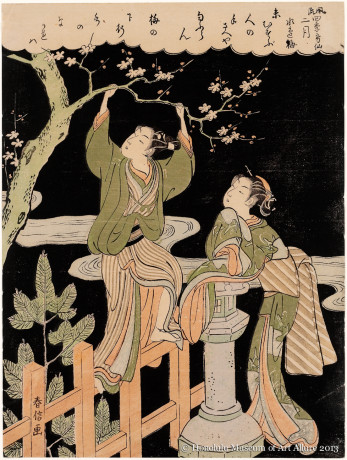Suzuki Harunobu (1725?-1770)
Second Month: Plum Tree at the Water’s Edge,
from the series Fashionable Versions of Poetry Immortals in the Four Seasons
Japan, Edo period, c. 1768
Woodblock print; ink and color on paper
Gift of James A. Michener, 1991
Honolulu Museum of Art
(21738)
Even the hand that scoops water to drink
Likely has a fragrant glow;
A stream flows beneath the blossoming plum tree.
Seasonal associations have always been important in Japanese art, and were featured in ukiyo-e to provide additional layers of meaning. The seasons further offered opportunities for series of designs (which could increase sales by encouraging collectors to acquire the entire set), and Harunobu’s publishers frequently took advantage of this, with the present and the following two prints coming from two different series, the titles of which vary only slightly.
Second Month uses spring to symbolize new love, with a suitor surreptitiously taking plum blossoms from the grounds of a shrine for his beloved, who shades the lantern with her sleeve to keep him from being seen. The couple’s relationship is reflected in their outfits, with outer layers of the same color, and the woman’s striped obi smartly matching the man’s robe.
View info on museum database (enabled through support by the Robert F. Lange Foundation)


